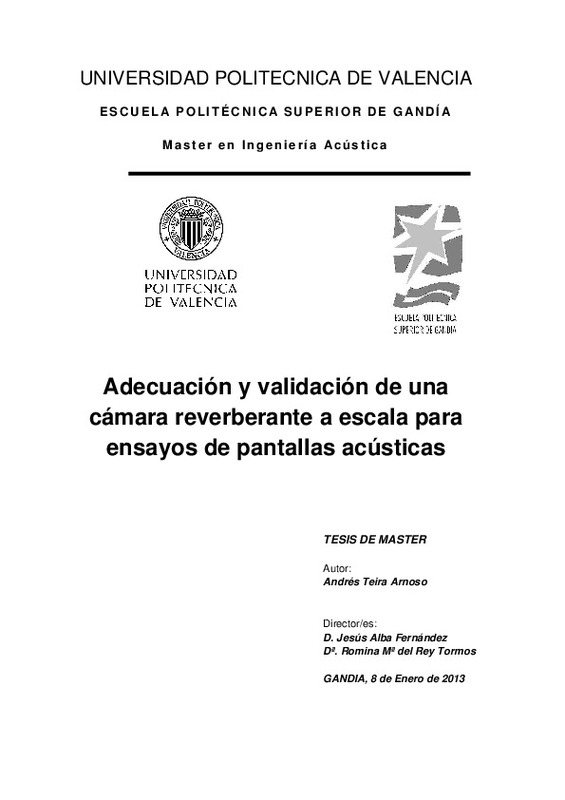|
Resumen:
|
El principal objetivo de este trabajo de fin de máster es caracterizar y acondicionar una cámara reverberante a
escala, de manera que sea un recinto en el que ensayar con fiabilidad, a medias y altas frecuencias, ...[+]
El principal objetivo de este trabajo de fin de máster es caracterizar y acondicionar una cámara reverberante a
escala, de manera que sea un recinto en el que ensayar con fiabilidad, a medias y altas frecuencias, el
coeficiente de absorción de materiales y pantallas acústicas. La cámara reverberante es uno de los
laboratorios acústicos más utilizados para determinar el coeficiente de absorción de materiales o la potencia
acústica radiada por diferentes emisores. Contamos con una serie de normas que definen las condiciones
tanto del recinto de ensayo, como de los materiales o dispositivos expuestos a estudio. En el cálculo del
coeficiente de absorción acústica, las superficies de los materiales a ensayar deben estar comprendidas entre
10 y 12 m2 (UNE-EN ISO 354:2004). Sin embargo, a nivel de investigación de nuevos materiales acústicos,
en la mayoría de los casos sólo se dispone de pequeñas probetas que no llegan a las dimensiones requeridas.
Por ello se ha diseñado y construido un recinto de ensayo de menores dimensiones que la cámara
reverberante de la EPSG, concretamente a escala 1:6, para poder trabajar con muestras de reducido tamaño.
Debido a sus características físicas, como la longitud de las aristas o el volumen del recinto, entre otras, los
resultados del coeficiente de absorción obtenido para diferentes materiales distan significativamente de los
obtenidos en la cámara reverberante de la escuela. Es por ello que creemos necesaria una caracterización de
la cámara y una mejora en las condiciones de ensayo para alcanzar resultados más fidedignos.
[-]
The main objective of this work is to describe and condition a scale reverberation chamber, so that is a room
in which to test reliability, mid and high frequencies, the absorption coefficient of acoustic materials ...[+]
The main objective of this work is to describe and condition a scale reverberation chamber, so that is a room
in which to test reliability, mid and high frequencies, the absorption coefficient of acoustic materials and
screens. The reverberation chamber is one of the most used acoustic laboratories to determine the absorption
coefficient of materials or sound power radiated by different sources. We have a set of rules that define the
conditions both in the test chamber, as the materials or devices subject to study. In the calculation of the
acoustic absorption coefficient of the surfaces of the materials to be tested should be between 10 and 12 m2
(UNE-EN ISO 354:2004). However, at the level of acoustic materials research, in most cases only small
samples are available that do not reach the required dimensions.
Therefore it has been designed and built a test chamber, smaller than the EPSG reverberation chamber,
specifically 1:6 scale, to work with small sample size. Because of their physical characteristics, such as edge
length or volume of the enclosure, among others, the results of the absorption coefficient obtained for
different materials significantly far from those obtained in the reverberation room of the school. That is why
we need a characterization of the camera and improved the test conditions to reach more reliable results
[-]
|







